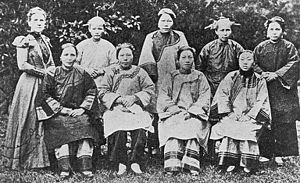
In missions history, a Bible woman was a local woman who supported foreign female missionaries in their Christian evangelistic and social work.

In missions history, a Bible woman was a local woman who supported foreign female missionaries in their Christian evangelistic and social work.
The title "Bible woman" was first used in London in connection with a female evangelist, Ellen Henrietta Ranyard, who put effort to reach sick and poor women in the poorest area of London in the mid-nineteenth century. Ranyard's heart was heavily burdened with the poor condition of women in St. Giles district that she decided to start an evangelistic work among them. Ranyard found a Christian woman who had a similar life as such and hired the woman to go with her to the poorest district in London to evangelize and help the sick women there. The woman who had the similar life as her recipients would freely visit the poor women and read the Bible to their hearings. She also distributed the Bible and tracts to the area, this is why she was called Bible woman. From this little seed, sprang Ranyard's mission. In 1879, there were about 170 Bible women employed in the mission. After Ellen Ranyard's death in 1879, her work was continued as the London Bible and Domestic Female Mission. The idea of "Bible women" did not stay in her home of origin, in London, but spread throughout England, Scotland, and it travelled to Asia, Africa, and rest of the non-western world with women missionaries. [1] An English example was Ann Baker (1834-1913), who served in the district which later became the Church of England parish of Emmanuel in Cheltenham, where there is a plaque in the church marking her 46 years of service.
At the beginning of the nineteenth century, the creation of many interdenominational mission organizations was influenced by the Evangelical revivals, anti-slavery movements, and free trade theories, especially in Britain. The urge to preach the gospel to individuals shifted to nations and was motivated not only by religious zeal but was also inspired by Enlightenment ideology (which saw liberation and salvation of the world as an equal) to improve one's self to contribute the global progress. [2] In this context, Protestant missionary women from the western world became increasingly interested in mission and trained themselves as educators, doctors, nurses, and other professionals to join in the mission work. They played a central role in mission fields as doctors, nurses, and teachers; they ran schools, hospitals and orphanages for children, etc. By the beginning of the twentieth century, most of the missionaries operating in the mission field were women. [3]
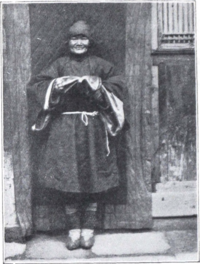
In the mission field, "Bible women" or "Bible readers" were local indigenous women. Initially, Bible women were recruited from domestic workers in missionary homes, from the wives and mothers of indigenous male evangelists, or graduates from missionary girl's schools. [4] [5] The majority of them held lower social status in their respective countries. [6] They were either supported by female missionaries or by local churches but were usually the lowest paid or even sometimes they were unpaid. [7] These local Christian women helped the British missionaries, especially female missionaries to perform their daily tasks and to accomplish their mission goal. Ruth Tucker argues that "without Bible Women, female missionaries would have been at a loss." [8]
Accompanying western missionaries on their missions were a significant part of Bible women ministry, but on many occasions, they served alone or in teams without any direct assistance from the missionaries. [1] Their ministry was wide in its range: they openly shared their faith with their fellow women, read the Bible in communities, taught children in village schools, called on the sick or troubled, worked among girls, and visited women in their homes. Bible women served as evangelists not only in their homelands but also in foreign settings. [9] In the beginning of the 20th century, there were a number of Korean Bible women in Manchuria, Japan, and Hawaii sharing Bible stories with women and children, [10] as well as Chinese Bible women such as Dora Yu in Korea, engaged in educational, medical, and evangelistic work. [4] Bible women also itinerated in villages to distribute and sell Bibles, tracts, and religious literature.
In 1913, thirty-six Bible women were employed by the British and Foreign Bible Society for the purpose of helping distribute scripture, and this practice continued with other Bible societies. [11] Even though there were few who wished to buy the Bible, [12] Bible women were successful in winning women for the Gospel. The Bible women were more effective in their evangelistic task than that of missionary women because they had open access to local women, girls, and children. In addition, they did not have a language barrier as most of the missionaries did have. Although Bible women focused on ministering to other women, occasionally, there were opportunities to minister to men as well. [11]
Initially, Bible women were trained by women missionaries on an individual basis. [8] They were taught the Bible, but on occasion, they were taught nursing, writing, homemaking, and health. [13] However, in later years, the number of Bible women increased and female training schools were opened: in China, alone, forty girls' schools were running in 1900. [13] Bible women were trained as Bible teachers, nurses, and healthcare providers. Bible women who had a solid foundation in biblical studies were trained to be Bible teachers.
In Sudan, Bible women used a book entitled One Hundred Lessons from the Bible that took the student through the Bible in outlined studies that involved answering questions and memorizing verses. Following the one hundred lessons, there was a "Way of Salvation" series that was geared to bring the student to a personal commitment to Christ. [14]
Bible women were actively involved in medical ministry too. They were taught basic medical skills by their female medical missionaries and then they worked as nurses and healthcare providers; they cared patients and shared the Gospel with them. [15]
Although Bible women played a major role in evangelizing their fellow women in their countries, they are largely left behind in contemporary study of Christian mission. There are not many records of Bible women today, neither of their successes nor their failures. It is because women were disregarded in their own cultures or may be they were ignored by their western male and female missionaries. Although they were the least known evangelists, Bible women played a major role in spreading Christianity in their homelands and beyond. [16]
This timeline of Christian missions chronicles the global expansion of Christianity through a listing of the most significant missionary outreach events.
The Third Great Awakening refers to a historical period proposed by William G. McLoughlin that was marked by religious activism in American history and spans the late 1850s to the early 20th century. It influenced pietistic Protestant denominations and had a strong element of social activism. It gathered strength from the postmillennial belief that the Second Coming of Christ would occur after mankind had reformed the entire Earth. It was affiliated with the Social Gospel movement, which applied Christianity to social issues and gained its force from the awakening, as did the worldwide missionary movement. New groupings emerged, such as the Holiness movement and Nazarene and Pentecostal movements, and also Jehovah's Witnesses, Spiritualism, Theosophy, Thelema, and Christian Science. The era saw the adoption of a number of moral causes, such as the abolition of slavery and prohibition.
A Christian mission is an organized effort to carry on evangelism or other activities, such as educational or hospital work, in the name of the Christian faith. Missions involve sending individuals and groups across boundaries, most commonly geographical boundaries. Sometimes individuals are sent and are called missionaries, and historically may have been based in mission stations. When groups are sent, they are often called mission teams and they undertake mission trips. There are a few different kinds of mission trips: short-term, long-term, relational and those that simply help people in need. Some people choose to dedicate their whole lives to mission.

In the early 19th century, Western colonial expansion occurred at the same time as an evangelical revival – the Second Great Awakening – throughout the English-speaking world, leading to more overseas missionary activity. The nineteenth century became known as the Great Century of modern religious missions.
American Southern Methodist Episcopal Mission was an American Methodist missionary society operated by the Methodist Episcopal Church, South that was involved in training and sending workers to urban centers in the U.S. as well as to other countries. The Board of Foreign Missions approved those missionaries who were sent to work in evangelical projects. Missions began in China during the late Qing Dynasty.
Foreign Christian Missionary Society (FCMS) was a Christian missionary society established by the Disciples of Christ. The Foreign Christian Missionary Society was established toward the end of 1876. The Society was organized for three main reasons:
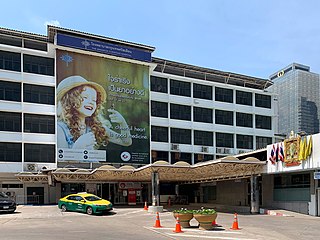
Christianity was first introduced to Thailand by European missionaries. In 2021, it represented 1.2% of the national population, which is predominantly Buddhist. Christians are numerically and organizationally concentrated more heavily in the north, where they make up an estimated 16% of some lowland districts and up to very high percents in tribal districts.
Characteristic of Christianity in the 19th century were evangelical revivals in some largely Protestant countries and later the effects of modern biblical scholarship on the churches. Liberal or modernist theology was one consequence of this. In Europe, the Roman Catholic Church strongly opposed liberalism and culture wars launched in Germany, Italy, Belgium and France. It strongly emphasized personal piety. In Europe there was a general move away from religious observance and belief in Christian teachings and a move towards secularism. In Protestantism, pietistic revivals were common.
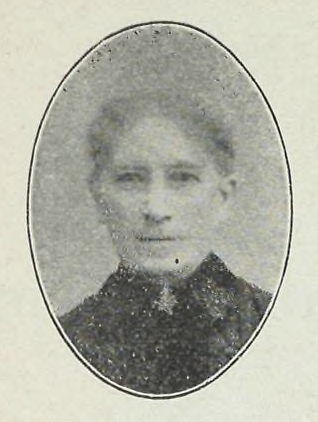
Mary Fletcher Benton Scranton was an American Methodist Episcopal Church missionary. She was the first Woman's Foreign Missionary Society of the Methodist Episcopal Church representative to Korea and the founder of the Ewha Girls School under Emperor Gojong. Today, the Ewha Girls School is the Ewha Womans University, one of the most prestigious women's schools in Asia. Scranton also founded the Tal Syeng Day School for Women in Seoul and the Training School for Bible Women.
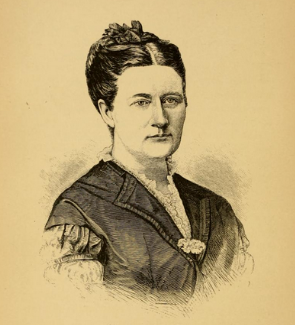
Clara A. Swain was an American physician and Christian missionary of the Methodist Episcopal Church. She has been called the "pioneer woman physician in India," and as well as the "first fully accredited woman physician ever sent out by any missionary society into any part of the Non-Christian world". Her call to service in India fell from a need to have a female physician provide quality medical care to high-caste women, that were religiously secluded to zenana. Supported by the Woman's Foreign Missionary Society of the Methodist Episcopal Church, Swain left the United States in 1869, for Bareilly, India, where she spent the next twenty-seven years of her life treating women and children from illnesses, while simultaneously working to evangelize natives.
Pentecostalism is a renewal movement within Protestant Christianity that places special emphasis on a direct personal relationship with God and experience of God through the baptism with the Holy Spirit. For Christians, this event commemorates the descent of the Holy Spirit upon the followers of Jesus Christ, as described in the second chapter of the Book of Acts. Pentecostalism was established in Kerala, India at the start of the 20th century.

The zenana missions were outreach programmes established in British India with the aim of converting women to Christianity. From the mid 19th century, they sent female missionaries into the homes of Indian women, including the private areas of houses - known as zenana - that male visitors were not allowed to see. Gradually these missions expanded from purely evangelical work to providing medical and education services. Hospitals and schools established by these missions are still active, making the zenana missions an important part of the history of Christianity in India.
Woman's Union Missionary Society of America for Heathen Lands was an American Christian mission organization. Established in 1861, its headquarters were at 41 Bible House, Astor Place, New York City. The first meeting called to consider organizing a society was gathered in a private parlor in New York City on January 9, 1861, and addressed by a returned missionary from Burma. At a subsequent meeting on January 10, the organization was effected, with Sarah Platt Doremus as president. The society's object was to "send out and maintain single women as Bible-readers and teachers, and to raise up native female laborers in heathen lands".

The Bethel Mission in Shanghai was an independent evangelistic institution established by Shi Meiyu, Phebe Stone, and Jennie V. Hughes in 1920. It would eventually include primary and secondary schools, a hospital and nursing school, an orphanage, and, through a revival led by Paget Wilkes in 1925, the Bethel Bible School.

Belle Harris Bennett led the struggle for and won laity rights for women in the Methodist Episcopal Church, South. She was the founding president of the Woman's Missionary Council of the Southern Methodist Church. Much of her work including fundraising and organizational efforts to provide higher education for a new professional class of social workers and community organizers in the Southern Methodist Church in the U.S. and abroad. Her carefully collaborative support for African Americans and immigrants was considered radical at that time by Southerners. She was a suffragist and supporter of temperance as well.

Lillias Horton Underwood, born Lillias Stirling Horton, was an American physician and Presbyterian missionary in Korea, alongside her husband Horace Grant Underwood. She served as personal physician to Empress Myeongseong.
Women's missionary societies include a diverse set of scopes, including medical, educational, and religious. Societies provide services in-country and in foreign lands.
Elisabeth Johanna Shepping was a German-born American nurse and missionary who served in South Korea for 22 years. Shepping was born in a Roman Catholic family but later converted to Protestantism after emigrating to America and becoming a nurse. Shepping was named one of the "Top 7 Greatest Missionary" by the Department of Foreign Missions of the Southern Presbyterian Church and described by the former Minister of Health and Welfare as the "Pioneer of [the] Korean feminist movement". Shepping founder the Neel Bible School which became the Hanil University and Presbyterian Theological Seminary. She also founded the E-il school for women.

Folts Mission Institute was a Methodist training school for young women for home and foreign Christian mission work. It was founded at Herkimer, New York, November 1893, by George Philo Folts and his wife, Elizabeth Snell Folts. In October 1898, after the death of Elizabeth Folts and to honor her expressed wish, George Folts presented the Institute to the Woman's Foreign Missionary Society of the Methodist Episcopal Church. The gift was accepted by the General Executive Committee, however, the transfer of deeds and property was never made. The Institute remained a private institution, but for several years, it was under the management of the Woman's Foreign Missionary Society. In 1914, the control of the Institute was transferred to the Woman's Home Missionary Society of the Northern New York Conference of the Methodist Episcopal Church. The school ended operations in 1927/28.